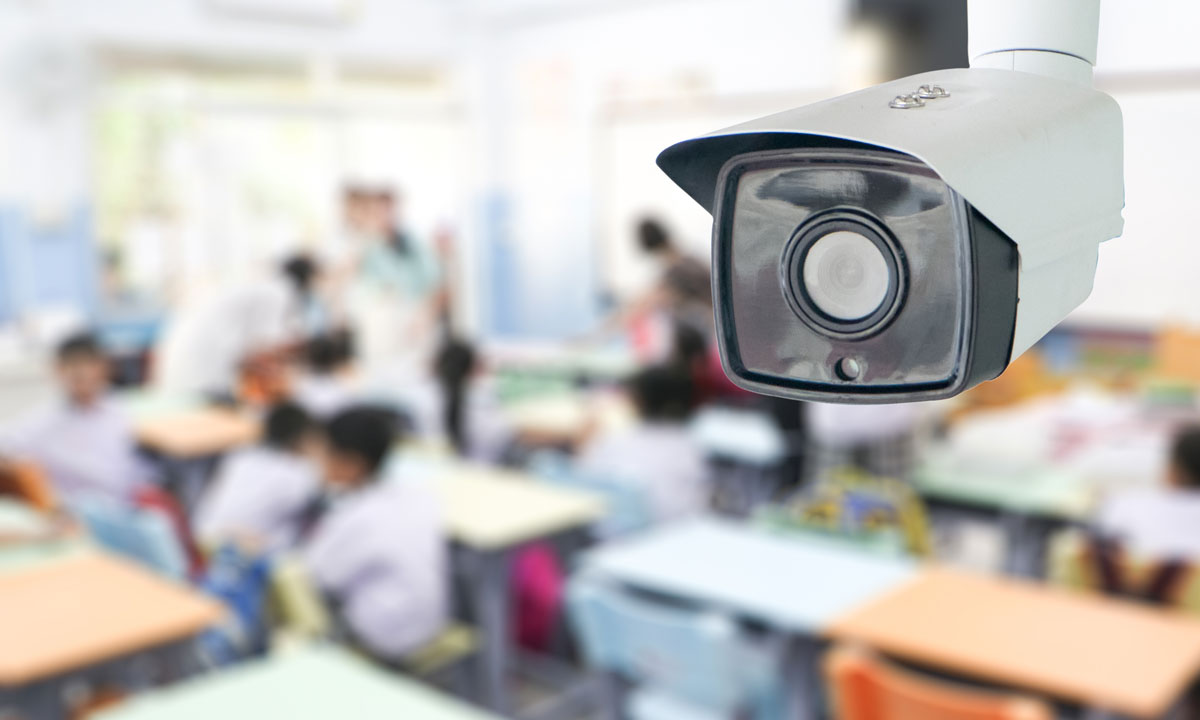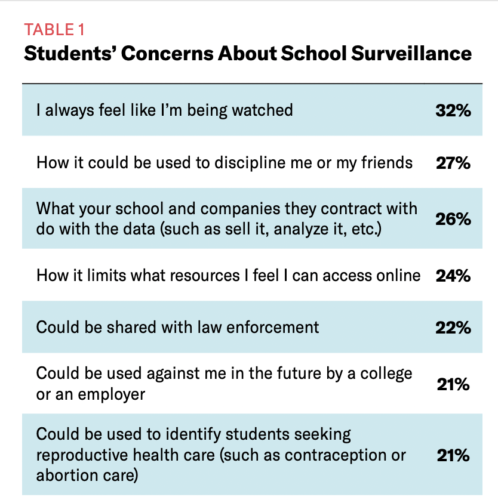New Report: School Shootings Spawned ‘Digital Dystopia’ of Student Surveillance
Monitoring tools have become ubiquitous in U.S. schools, but new ACLU research argues the harms outweigh the benefits.

Get stories like this delivered straight to your inbox. Sign up for The 74 Newsletter
Updated, Oct. 4
Reeled in by deceptive, fear-based marketing and an influx of federal cash, school leaders have purchased and pervasively deployed student surveillance tools while failing to consider their detrimental consequences to young people’s civil rights, a new ACLU report concludes.
In a youth survey accompanying the American Civil Liberties Union report released Tuesday, a majority of students expressed worries that the tools — designed to keep them safe — could actually cause harm and a third said they “always feel” like they’re being watched.
The 61-page report, titled “Digital Dystopia,” also offers an in-depth look at the rise of schools’ reliance on surveillance technology over the last few decades, arguing the tools have failed to improve campus safety while subjecting students — particularly students of color and those who are undocumented, LGBTQ or from low-income households — to discrimination.
“The ed tech surveillance companies, after fanning the flames of fear, were making these broad statements about the efficacy of their products, about their ability to keep students safe” from threats like school shootings and suicide, despite a lack of evidence to back up their claims, report lead author and ACLU senior policy counsel Chad Marlow told The 74.
Rather than making kids safe, Marlow said, the tools could be damaging to their development and well-being. “The harm is actually significant and, by not acknowledging the harms that are caused, there’s less incentive to look at other interventions,” he said.

Three-quarters of students worry about at least one negative consequence of student surveillance, which includes the widespread proliferation of digital tools that monitor their online communications for references to sex, drugs, violence or self-harm, according to the online survey. Commissioned by the ACLU, the polling firm YouGov queried 502 teens throughout the country in October 2022. Nearly a quarter of respondents said that digital monitoring tools limit the resources they feel they can access online while a similar percentage worried the information collected about them could be shared with the police or be used against them in the future by a college or an employer. Some 27% feared the tools could be used for disciplinary purposes.
As a result, students alter their behaviors due to fears that “deviating from expectations is punishable in the world that they’re growing up in,” Marlow said. “What does that tell them about innovation or exploring new ideas?”
Survey findings resemble those from another youth survey, released last month by the nonprofit Center for Democracy and Technology, which found that while a majority of parents and students still embrace digital tools that monitor students’ online behaviors, their support has dwindled over the last year.
Both reports identified detrimental effects of digital surveillance that researchers said run counter to federal civil rights laws that protect students from discrimination based on race, disability, sexual orientation or gender identity.
In the student survey conducted by the Center for Democracy and Technology, researchers found that while districts bought digital monitoring tools to keep students safe, they are used regularly as discipline tools that routinely bring youth in contact with the police. LGBTQ+ youth and those with disabilities were significantly more likely to experience the harms of surveillance. For example, 65% of LGBTQ+ youth said they or someone they knew got into trouble due to online activity monitoring, compared to 56% of their straight and cisgender peers. Meanwhile, nearly a third of LGBTQ+ students said that they or someone they know has been “outed” by the technology.
In the absence of rigorous, independent research on the efficacy of school surveillance tools to improve campus safety, the ACLU report argues that schools are left to make purchasing decisions based on what the group called fear-based marketing tactics. Security companies hype the risks of school violence and student self-harm while overstating the utility of their products, the report says. Security industry lobbying efforts, meanwhile, have successfully steered hundreds of millions of dollars in government school safety spending toward unproven technologies.
“It would be like going to buy a car and the only source of information is the car salesperson,” Marlow said. “That’s probably not the best way to make a car purchasing decision, but that’s what’s happening with student surveillance.”
The Security Industry Association, a trade group that represents security companies and lobbies on their behalf, didn’t immediately respond to a request for comment.
The ACLU survey results suggest, however, that students have a complicated relationship with school surveillance: While recognizing its potential harms, many also believe it serves its intended purpose. Specifically, 40% of students reported that surveillance technology makes them feel “safe” and 43% said it makes them feel “protected.” Meanwhile, just 14% said it makes them feel “anxious” and a fraction of respondents, 7%, said the tools made them feel “unsafe.”
Marlow said this support may be the result, at least in part, of successful marketing and a belief that few other options exist.
“When you talk about keeping students safe, I think students are smart enough to realize that in too many places in this country, gun control is off the table,” he said. “Because of the dominance of money and power of the ed tech surveillance industry,” that’s used in marketing and lobbying, “the discussion is almost entirely centered around, ‘Do we use or do we not use student surveillance technologies?’ while alternatives like mental health screenings fail to receive similar consideration. “In that option, between a highly questionable, harmful protection or nothing at all, no one wants to pick nothing at all.”
While the report focuses largely on digital tools that monitor students’ behaviors online, it also questions the efficacy of surveillance cameras in creating physical safety for students in schools. Cameras have become nearly ubiquitous, with 91% of districts equipping their schools with them in the 2019-20 school year, according to the most recent data included in a U.S. Department of Education report released last month.
Meanwhile, just 55% of schools offered students mental health assessments, according to the most recent federal data, and 42% offered mental health treatment services.
Despite a sharp rise in schools’ reliance on surveillance and other tools in the last two decades, the number of school shootings has grown.
There were a record 188 school shootings resulting in injuries or deaths in the 2021-22 school year, according to the federal report. That’s twice as many shootings on campus than the previous record — set just one year earlier. Placing security cameras in schools, Marlow argues, has failed to deter the very crimes they were installed to prevent. In an ACLU analysis of the 10 deadliest school shootings in the last two decades, for example, researchers found that surveillance cameras were present for eight, including in Parkland, Florida, and Uvalde, Texas.
Along with scrutiny from researchers and civil rights groups, schools’ use of digital monitoring tools has led to several lawsuits alleging they’re ineffective and violate students’ civil liberties.
In one class-action lawsuit, filed this year in California, the parents of two students claim the student surveillance company Securly secretly collected physical location data from childrens’ mobile devices and sold the information to targeted advertising vendors without their knowledge or consent.
A separate federal negligence lawsuit, filed in 2021 in Oklahoma, accuses the digital surveillance company Gaggle of being ineffective at keeping kids safe from self-harm. The lawsuit, filed by the parents of a 15-year-old boy who died by suicide, accuses the surveillance company and the state’s third-largest school district of failing to act on warning signs that could have prevented the teenager’s 2019 death.
The student submitted a “personal odyssey” essay in his freshman English class that was riddled with references to self-harm and suicide, but his teacher failed to act, the complaint alleges, giving him a grade of 100%. The district used Gaggle to identify and flag troubling student digital communications, including references to self-harm and suicide. Yet the lawsuit alleges the company “failed to notify school administration” about the student’s warning signs, including the essay titled “Running Out of Reasons” and an email with a classmate where the two contemplated a plan to “go out at the same time.”
A Gaggle spokesperson didn’t immediately respond to a request for comment. Securly spokesperson Josh Mukai called the lawsuit “baseless and uninformed.”
“Securly has never sold student data to third parties, nor have we ever used student data to target advertisements,” Mukai said in an email. “Securly’s suite of student safety solutions upholds the highest standards for student data privacy and complies with all international, federal and state privacy regulations.”
Get stories like these delivered straight to your inbox. Sign up for The 74 Newsletter

;)
